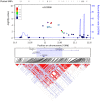Common variants on chromosome 9p21 are associated with normal tension glaucoma
- PMID: 22792221
- PMCID: PMC3390321
- DOI: 10.1371/journal.pone.0040107
Common variants on chromosome 9p21 are associated with normal tension glaucoma
Abstract
Although intraocular pressure (IOP) is the most definitive cause of glaucoma, a subtype of open angle glaucoma (OAG) termed normal tension glaucoma (NTG), which occurs in spite of normal IOP, accounts for a large part of glaucoma cases, especially in Japan. To find common genetic variants contributing to NTG in Japanese patients, we conducted a genome-wide association study (GWAS). We performed the first screening for 531,009 autosomal SNPs with a discovery cohort of 286 cases and 557 controls, and then a second screening for the top 30 suggestive loci in an independent cohort of 183 cases and 514 controls. Our findings identified a significantly associated SNP; rs523096 [combined p-value = 7.40× 10(-8), odds ratio (OR)= 2.00 with 95% confidence interval (CI) 1.55-2.58] located 10 kbp upstream of CDKN2B on chromosome 9p21. Moreover, analysis of another independent case-control set successfully replicated the results of the screening studies (combined values of all 3 stages p = 4.96 × 10(-11), OR= 2.13 with 95% CI 1.69-2.68). The SNPs near rs523096 were recently reported to be associated with OAG associated with elevated IOP in primary open-angle glaucoma (POAG), the predominant subtype of glaucoma in Caucasian populations. Our results revealed that the 9p21 locus is also associated with NTG in Japanese. In addition, we identified SNPs more strongly associated with NTG.
Conflict of interest statement
Figures


Similar articles
-
Glaucoma risk alleles at CDKN2B-AS1 are associated with lower intraocular pressure, normal-tension glaucoma, and advanced glaucoma.Ophthalmology. 2012 Aug;119(8):1539-45. doi: 10.1016/j.ophtha.2012.02.004. Epub 2012 Apr 21. Ophthalmology. 2012. PMID: 22521085
-
Genetic Association at the 9p21 Glaucoma Locus Contributes to Sex Bias in Normal-Tension Glaucoma.Invest Ophthalmol Vis Sci. 2016 Jun 1;57(7):3416-21. doi: 10.1167/iovs.16-19401. Invest Ophthalmol Vis Sci. 2016. PMID: 27367510
-
Common variants in CDKN2B-AS1 associated with optic-nerve vulnerability of glaucoma identified by genome-wide association studies in Japanese.PLoS One. 2012;7(3):e33389. doi: 10.1371/journal.pone.0033389. Epub 2012 Mar 12. PLoS One. 2012. PMID: 22428042 Free PMC article.
-
Chromosome 9p21 primary open-angle glaucoma susceptibility locus: a review.Clin Exp Ophthalmol. 2014 Jan-Feb;42(1):25-32. doi: 10.1111/ceo.12234. Epub 2013 Oct 30. Clin Exp Ophthalmol. 2014. PMID: 24112133 Review.
-
[Open-angle glaucoma clinical presentation and management].Nippon Ganka Gakkai Zasshi. 2001 Dec;105(12):828-42. Nippon Ganka Gakkai Zasshi. 2001. PMID: 11802456 Review. Japanese.
Cited by
-
Investigation of known genetic risk factors for primary open angle glaucoma in two populations of African ancestry.Invest Ophthalmol Vis Sci. 2013 Sep 17;54(9):6248-54. doi: 10.1167/iovs.13-12779. Invest Ophthalmol Vis Sci. 2013. PMID: 23963167 Free PMC article.
-
Expansive marker analysis replicating the association of glaucoma susceptibility with human chromosome loci 1q43 and 10p12.31.Eur J Hum Genet. 2014 Mar;22(3):409-13. doi: 10.1038/ejhg.2013.149. Epub 2013 Jul 10. Eur J Hum Genet. 2014. PMID: 23838595 Free PMC article.
-
Genetic Risk Factors for Glaucoma and Exfoliation Syndrome Identified by Genome-wide Association Studies.Curr Neuropharmacol. 2018;16(7):933-941. doi: 10.2174/1570159X15666170718142406. Curr Neuropharmacol. 2018. PMID: 28721823 Free PMC article. Review.
-
Asian Race and Primary Open-Angle Glaucoma: Where Do We Stand?J Clin Med. 2022 Apr 28;11(9):2486. doi: 10.3390/jcm11092486. J Clin Med. 2022. PMID: 35566612 Free PMC article. Review.
-
Gene expression-based comparison of the human secretory neuroepithelia of the brain choroid plexus and the ocular ciliary body: potential implications for glaucoma.Fluids Barriers CNS. 2014 Jan 29;11(1):2. doi: 10.1186/2045-8118-11-2. Fluids Barriers CNS. 2014. PMID: 24472183 Free PMC article.
References
-
- Kerrigan LA, Zack DJ, Quigley HA, Smith SD, Pease ME. TUNEL-positive ganglion cells in human primary open-angle glaucoma. Arch Ophthalmol. 1997;115:1031–1035. - PubMed
-
- Quigley HA, Addicks EM. Regional differences in the structure of the lamina cribrosa and their relation to glaucomatous optic nerve damage. Arch Ophthalmol. 1981;99:137–143. - PubMed
-
- Allingham RR, Shields MB. Shields' textbook of glaucoma. Philadelphia: Lippincott Willliams & Wilkins. xiii, 702 p. 2005.
-
- Leske MC, Heijl A, Hussein M, Bengtsson B, Hyman L, et al. Factors for glaucoma progression and the effect of treatment: the early manifest glaucoma trial. Arch Ophthalmol. 2003;121:48–56. - PubMed
Publication types
MeSH terms
LinkOut - more resources
Full Text Sources
Other Literature Sources

